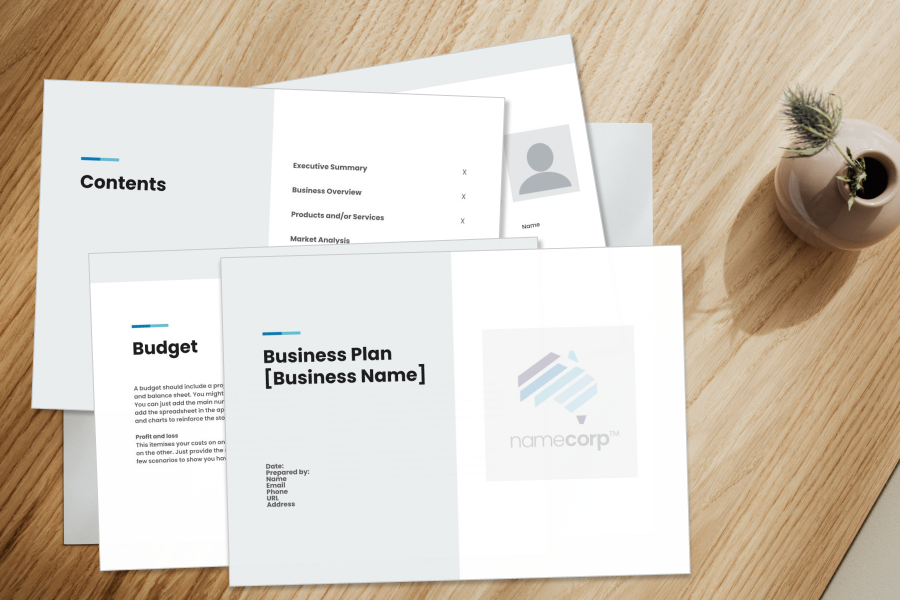How to Write a Business Plan & Free Business Plan Template
Suppose you’re embarking on starting your own business. In that case, developing a business plan will be essential for planning priorities and budgets, applying for credit and overall setting you up for success. This blog will help you understand how to write a business plan. Plus, we have a free business plan template you can use.
Before diving into the steps to write a business plan, let’s get the definitions out of the way first.
What is a Business Plan?
A business plan is a document outlining the goals and strategies of a company. Consisting of about 40 to 50 pages, this document is beneficial for new ventures as it details the plans for future growth. Some aspects covered in the business plan are new products and services, getting resources, cash flow projections, and more. This will be specified more thoroughly later in this post.
Fledgling entrepreneurs often use the concepts of a business plan and business model interchangeably, which is incorrect. While a business plan is focused on the purpose, goals, mission, finances, target market, and the like, a business model is more inclined towards the procedures and methods used to implement the business plan for quick growth.
Guidelines for Creating a Business Plan
Before writing down your business plan, keep these few tips in mind.
- Evaluate the reasons for creating a business plan
Determine the reasons for creating a business plan for which you must be clear about the goals you want to achieve. For example, if you plan to launch a new product, include your projections of target customers, the niche market, and so on. Your business plan will reflect all these parameters.
- Fix a time limit for meeting the goals
Give yourself a time limit for meeting the goals included in the business plan. Keep a period of a few months for short-term goals like paying off temporary debts and one to two years for long-time purposes like modifying brand identity or actions that require a shift in the industry.
- Set reasonable goals
Do not set goals that you will find challenging to meet. For example, if you push too hard toward exponential growth without making adequate provisions for finance, you will not be able to achieve your objectives. Start-ups especially should aim for slow but solid growth over time. Evaluate the company mission statement and prioritise the most reasonable goals.
- Integrate graphs and images to back up the written business plan
Include charts and graphs to stay engaged and better understand all the data incorporated into the business plan. Charts also help to get more clarity when comparing two sets of figures, like profit and loss projections over the first three years.
- Keep the business plan flexible.
While a business plan will excellently steer you towards your mission statement, it should be very flexible. Modifying the original plan to meet your shifting needs should always be a provision. If the processes and results differ from what was written in the original plan, you should be able to change some parameters without affecting the overall structure.
Now that you know what goes into creating a business plan, here are the steps required to write one.

How to Write a Business Plan in 11 Steps
Consider these 11 steps to writing a business plan exclusive to your business.
- Step 1 – Compile the executive summary.
The executive summary is the outline that reflects the contents of the business plan and defines your company and the niche you operate in. The summary is not standardised but flexible enough to cater to the business’s unique needs. Generally, it contains the mission statement, the products and services, names and bios of officials, the business’s location, financial details, and future ambitions. - Step 2 – Write a brief description of the business
This step goes a step further from the executive summary. Give an in-depth analysis of the purpose of the business, how it beats the competitors, types like B2B or B2C, proposed product launches, customer base and demographics, and other relevant information. - Step 3 – Make a detailed market analysis.
This step in your business plan must have a detailed report of your competitors and how they stack up. However, to get it right, you should do a lot of industry research and gather key market trends and all information about your competitors. Make a summary of the competitors’ names, their product specialty, customer demographics and sales data, and brief reasoning why your venture can do better. All this data will help you design optimized digital marketing campaigns. - Step 4 – Write the organisational structure.
This management section should contain the internal structure of the company and procedures that contribute to its success. Give the type of corporation and the organisational chart that explains the chain of command. - Step 5 – Explain the products and services.
Go in-depth into what your company offers to customers. Include the history and description of each product and service, how they solve customer needs and importance, a review of their lifecycle, and any trademarks. - Step 6 – Explain your marketing and sales objectives
In this section, write about your plans for creating a loyal customer base and increasing brand awareness, as well as detailed marketing and sales strategies for achieving these goals. Project your approach’s effect on the brand image and the consumer. - Step 7 – Estimates of finances required
A business plan document is often placed before potential financiers to convince them to fund your venture. Hence, include in the business plan the amount of funds required, how the funds will be used, say over three years, state whether you need debt or equity, suggest the terms and conditions, and a summary of how you plan to pay back the debt over time. - Step 8 – Elaborate on the financial projections
This section will include your financial projections over a specific time frame. Some of the components here are balance sheets for running businesses, financial forecasts for start-ups, the revenue inflows that will assist in clearing the debts, cash flow, and funds to meet a sudden surge in demand for the products. - Step 9 – Risk Assessment
What are the threats that affect your business operations, and how do you plan to overcome them? For example, are you heavily reliant on one client to provide most of your revenue? Therefore if you lose this client, it will impact your revenue significantly. So the mitigation would be to diversify the client base. - Step 10 – Milestones
What is your roadmap for your first year or even the first few years? What are the key milestones to be achieved, and by when? Set up regular meetings to ensure you’re keeping track of progress. - Step 11 – An appendix
This last section of the business plans should have the essential documents, such as licenses and permits, product photos, credit history, and others significant to your company.
Free Business Plan Template

All businesses, from small to multimillion-dollar businesses, need a business plan. When you research and forecast financial projections, you think logically about income and expenses, reducing the risk of business failure.
Here is a free business plan template to help you create your business plan and get you on the path to success.
Get Help Setting Up Your Business
Getting your first business set up can be complicated, and you want to ensure your business is fully compliant with Australian laws and the relevant government bodies to start operating.
Namecorp is an ATO, and ASIC registered agent with years of experience helping businesses register their business legalities to ensure they operate compliantly in Australia. We can help you register for your ABN, which all companies in Australia are legally required to have. We can also help you register your business name, trademarks, and domain name for your website with a simple application process.
In addition, we offer many support services like free website design, discounted business insurance, discounted marketing materials and 24/7 support.
Disclaimer: All information provided on this webpage is general information about our business in Australia, and products and services. Nothing on this webpage is intended to be professional advice and should not be relied on as such. You should obtain specific financial, legal, or other professional advice before relying on the content of this webpage. By not seeking such advice, you accept the risk that the information on this webpage may not meet the specific needs of your business. Our liability is limited to the maximum extent permitted by applicable law in accordance with our website terms and conditions.

 1300 006 263
1300 006 263






